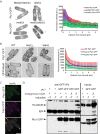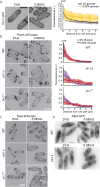Direct and indirect regulation of Pom1 cell size pathway by the protein phosphatase 2C Ptc1
- PMID: 33625871
- PMCID: PMC8108516
- DOI: 10.1091/mbc.E20-08-0508
Direct and indirect regulation of Pom1 cell size pathway by the protein phosphatase 2C Ptc1
Abstract
The fission yeast cells Schizosaccharomyces pombe divide at constant cell size regulated by environmental stimuli. An important pathway of cell size control involves the membrane-associated DYRK-family kinase Pom1, which forms decreasing concentration gradients from cell poles and inhibits mitotic inducers at midcell. Here, we identify the phosphatase 2C Ptc1 as negative regulator of Pom1. Ptc1 localizes to cell poles in a manner dependent on polarity and cell-wall integrity factors. We show that Ptc1 directly binds Pom1 and can dephosphorylate it in vitro but modulates Pom1 localization indirectly upon growth in low-glucose conditions by influencing microtubule stability. Thus, Ptc1 phosphatase plays both direct and indirect roles in the Pom1 cell size control pathway.
Figures




Similar articles
-
PKA antagonizes CLASP-dependent microtubule stabilization to re-localize Pom1 and buffer cell size upon glucose limitation.Nat Commun. 2015 Oct 7;6:8445. doi: 10.1038/ncomms9445. Nat Commun. 2015. PMID: 26443240 Free PMC article.
-
A phosphorylation cycle shapes gradients of the DYRK family kinase Pom1 at the plasma membrane.Cell. 2011 Jun 24;145(7):1116-28. doi: 10.1016/j.cell.2011.05.014. Cell. 2011. PMID: 21703453
-
Quantitative phosphoproteomics reveals pathways for coordination of cell growth and division by the conserved fission yeast kinase pom1.Mol Cell Proteomics. 2015 May;14(5):1275-87. doi: 10.1074/mcp.M114.045245. Epub 2015 Feb 26. Mol Cell Proteomics. 2015. PMID: 25720772 Free PMC article.
-
Microtubule-dependent cell morphogenesis in the fission yeast.Trends Cell Biol. 2009 Sep;19(9):447-54. doi: 10.1016/j.tcb.2009.06.003. Epub 2009 Aug 25. Trends Cell Biol. 2009. PMID: 19713114 Review.
-
Control of cellular organization and its coordination with the cell cycle.Biosci Biotechnol Biochem. 2020 May;84(5):869-875. doi: 10.1080/09168451.2020.1717926. Epub 2020 Jan 27. Biosci Biotechnol Biochem. 2020. PMID: 31987003 Review.
Cited by
-
The role of anillin/Mid1p during medial division and cytokinesis: from fission yeast to cancer cells.Cell Cycle. 2023 Mar-Mar;22(6):633-644. doi: 10.1080/15384101.2022.2147655. Epub 2022 Nov 25. Cell Cycle. 2023. PMID: 36426865 Free PMC article. Review.
-
Characterizing non-exponential growth and bimodal cell size distributions in fission yeast: An analytical approach.PLoS Comput Biol. 2022 Jan 18;18(1):e1009793. doi: 10.1371/journal.pcbi.1009793. eCollection 2022 Jan. PLoS Comput Biol. 2022. PMID: 35041656 Free PMC article.
-
Anterior-posterior pattern formation in ciliates.J Eukaryot Microbiol. 2022 Sep;69(5):e12890. doi: 10.1111/jeu.12890. Epub 2022 Feb 5. J Eukaryot Microbiol. 2022. PMID: 35075744 Free PMC article. Review.
References
-
- Arellano M, Niccoli T, Nurse P (2002). Tea3p is a cell end marker activating polarized growth in Schizosaccharomyces pombe. Curr Biol 12, 751–756. - PubMed
-
- Bähler J, Wu JQ, Longtine MS, Shah NG, McKenzie A 3rd, Steever AB, Wach A, Philippsen P, Pringle JR (1998). Heterologous modules for efficient and versatile PCR-based gene targeting in Schizosaccharomyces pombe. Yeast 14, 943–951. - PubMed
Publication types
MeSH terms
Substances
LinkOut - more resources
Full Text Sources
Other Literature Sources

